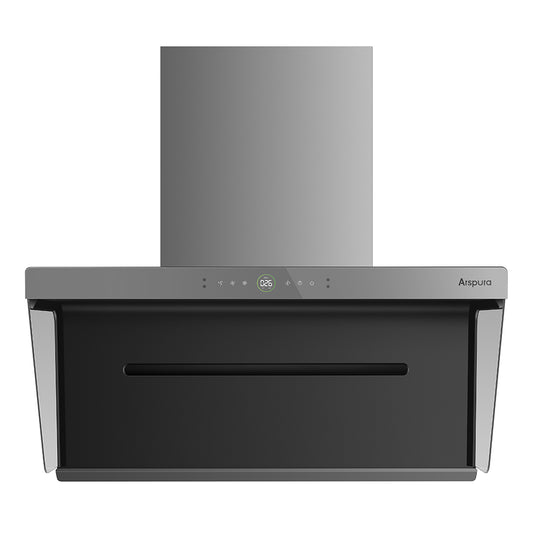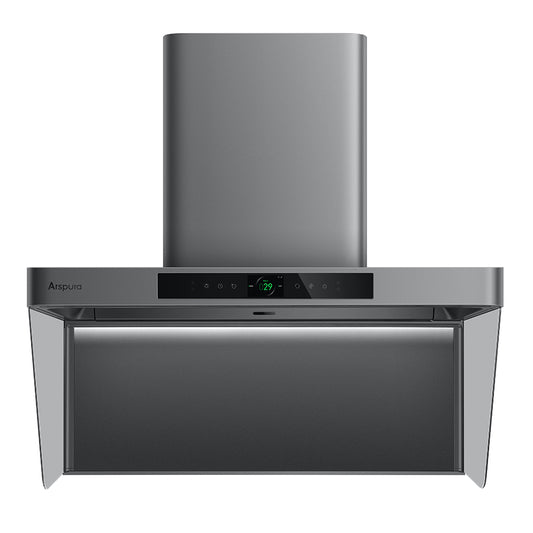The Definitive Guide to Range Hood Height Above a Stove
Setting the correct range hood height improves ventilation and keeps your cooking space safe. If you position the hood too high, smoke and odors escape into your kitchen. Installing it too low can make cooking difficult and cause safety hazards like bumped heads. Gas, electric, outdoor, and pro-style ranges often need different heights. The best range hood height depends on your cooktop type and kitchen layout.
This article explores the recommended mounting height for range hoods in different kitchen layouts. You’ll discover how the right installation improves ventilation, safeguards your cooking space, and keeps your kitchen both functional and stylish.
What's the Ideal Range Hood Height?
Proper mounting height plays a key role in maintaining safety and maximizing range hood performance. Placing the hood at an incorrect distance can reduce its smoke capture efficiency and overall performance. In most kitchens, a range hood works best when installed about 24 to 30 inches above the cooking surface, though the exact distance may vary depending on the model.
Arspura Mounting Height
For best performance, Arspura recommends maintaining a vertical clearance of 690–740 mm (27.17–29.13") between the cooktop and the bottom edge of the hood. Installing outside this range may compromise smoke extraction and affect overall ventilation efficiency.
With the correct mounting height, your Arspura hood can deliver consistent airflow and ensure a cleaner, healthier cooking environment.
Recommended Heights for Different Cooktops
Since different cooktops generate varying levels of heat, smoke, and grease, they also require different ventilation strengths. That’s why adjusting your range hood height to match your cooktop type is essential for effective performance and safety.
Electric Cooktops Height of Range Hood
Electric cooktops generate lower heat and no flames. The industry standard is 20–24 inches above the surface, with 20 inches considered safe. This closer height helps capture steam, smoke, and odors effectively before they spread throughout the kitchen.
Gas Stove Range Hood Height
Gas stoves produce open flames and high heat, so the hood must be higher. The recommended clearance is 24–30 inches, which balances safety and fume capture. For powerful, commercial-style gas ranges, experts may suggest 28–36 inches for added protection.
Range Hood Height for Induction Cooktops
Induction cooktops create little ambient heat and no flame. Some recommend a lower hood at 20–24 inches for maximum capture, while others allow 30–36 inches without much performance loss. The ideal height depends on balancing efficiency with user comfort.
Special Considerations for Outdoor Cooking Surfaces
Outdoor grills release stronger heat, smoke, and grease, requiring more clearance. Outdoor hoods should be installed 36–42 inches above the cooking area. This higher placement ensures safe operation and effective capture of heavy smoke plumes during grilling.
| Cooktop Type | Recommended Height Range (Inches) | Primary Justification |
|---|---|---|
| Electric | 20–24" | Lower heat output allows for closer, more effective capture. |
| Gas | 24–30" | Requires greater clearance due to open flames and high heat. |
| Induction | 20–36" | Varies based on priority: 20–24" for maximum capture of steam/odor, 30–36" for user comfort. |
| Outdoor | 36–42" | Necessitates a higher mount to handle extreme heat and smoke from grills. |
Why the Right Range Hood Height Is Important
Getting the range hood height right is crucial for both safety and performance. When it's too high, it won't effectively capture smoke, steam, and odors, letting them escape into your kitchen and leaving a greasy film on surfaces. This is because the hood's capture area isn't positioned correctly to create the necessary suction. On the other hand, if it's too low, it can become a fire hazard, especially with gas cooktops. A low-hanging hood can also obstruct your view and make it difficult to cook comfortably. Finding that perfect spot ensures your kitchen stays clean and your cooking environment remains safe.
The style of the range hood also plays a significant role to determine its ideal mounting height of the range hood. Here is recommended heights for different range hood:
| Range Hood Style | Recommended Mounting Height |
|---|---|
| Under-Cabinet Hoods | 18–24 inches |
| Wall-Mount / Chimney Hoods | Based on cooktop type (20–30 inches typical) |
| Island Hoods | 28–36 inches |
| Insert Hoods | 22–28 inches |
Essential Factors That Influence Your Installation Height
Please consider the following factors to determine the optimal height for mounting your range hood:
Range Hood Suction (Airflow Speed)
Airflow speed, or suction power, is a key factor affecting installation height. Higher airflow creates a stronger capture zone, efficiently removing smoke, grease, and odors—even if the hood is mounted slightly higher. Low-suction hoods may lose efficiency when installed above the recommended range, as fumes can disperse before being captured. Matching the hood’s suction power with the manufacturer’s recommended installation height ensures optimal performance, safety, and comfort. Selecting the right airflow strength allows flexibility in placement without compromising kitchen air quality.
User Ergonomics & Comfort
The height of the primary user is a practical consideration that affects the hood's usability and safety.
Head Clearance: The hood must be installed at a height that prevents the cook from bumping their head, making the cooking space comfortable and safe.
Access to Controls: The control panel should be within easy reach without requiring a stretch or a stool.
Aesthetics and Proportionality: The hood's height should look balanced and be in proportion with the surrounding cabinetry and the kitchen's overall design.
Kitchen Layout and Design
The physical space around the cooktop impacts mounting height and hood selection.
Ceiling Height: For high or vaulted ceilings, you may need a chimney extension kit or custom ductwork to ensure the hood reaches the necessary height without an awkward gap.
Proximity to Cabinets: The hood's placement must not interfere with the opening of adjacent cabinet doors. If the hood is wider than the cooktop, this is an especially important detail to consider.
Local Building Codes
Always check with your local building and safety codes before installation. Some areas have specific legal requirements for minimum clearance between a cooking appliance and the ventilation system, especially for commercial or multi-family properties. Adhering to these codes ensures both safety and compliance.
How do I measure the right height for my range hood?
Determining the correct installation height is the first step to ensuring your range hood works efficiently. Use the following guidelines to position your hood at the right level for both comfort and performance.
1. Measure the width of your cooktop
Place your tape measure from left to right. Your range hood should match this width or extend about 3 inches beyond each side for better coverage.
2. Check the space between your cabinets or walls
Measure the available width to make sure your hood fits without crowding.
3. Measure the installation height
Start at the top of your cooktop and measure up to where the bottom of the hood will sit. For electric cooktops, aim for 24 to 30 inches. For gas cooktops, use 28 to 36 inches. This step sets your range hood height.
4. Measure the depth of your cooktop
Go from the front edge to the back wall. Your hood should match or exceed this depth to capture all smoke and steam.
Tip: Always use a level when marking your measurements. This ensures your hood sits straight and looks professional.
Problems from Wrong Range Hood Height
Installing a range hood at the wrong height can lead to a host of problems, from performance issues to safety risks and long-term costs.
Installing Too Low: Safety and Durability Risks
Placing a range hood too close to the cooktop can have several negative consequences:
Fire Hazard: For gas cooktops, a hood that is too low can be a significant fire risk, especially if grease has built up on the surface.
Device Damage: Constant exposure to high heat can cause irreparable damage to the hood's motor, internal circuitry, and even its stainless steel exterior.
Reduced Motor Life: The motor has to work harder to filter out intense heat and fumes at close range, which can lead to overheating and a shorter lifespan.
Increased Cleaning: A lower hood is closer to the source of grease and dirt, meaning it and the surrounding surfaces will require more frequent cleaning, potentially every few weeks instead of monthly.
Installing Too High: Diminished Performance and Hidden Costs
Conversely, a range hood installed too high is equally problematic, though the issues may be less obvious.
Reduced Capture Efficiency: As cooking fumes rise, they expand into a cone shape. If the hood is too high, the plume will spread and escape the "capture area" before it can be effectively vented. This leads to smoke and grease lingering in the kitchen, coating walls and ceilings over time.
Higher Energy Bills: To compensate for poor capture efficiency, you might constantly run the hood at its highest speed, which not only consumes more energy but also pulls heated or cooled air out of your home, forcing your HVAC system to work overtime.
Increased Motor Wear: Operating the fan at max speed frequently puts extra strain on the motor, accelerating its wear and tear.
FAQs About Range Hood Mounting Height
What happens if you install a range hood too high?
If you install your range hood too high, it cannot capture smoke and odors well. Your kitchen air stays dirty. You may also notice more grease on cabinets and walls.
Tip: Always follow the recommended height for best performance.
Can you install a range hood lower than recommended?
You should not install your range hood lower than the manufacturer suggests. A low hood can block your view and make cooking uncomfortable. It may also create a fire risk if it sits too close to the heat.
Do ductless range hoods need the same height as ducted ones?
Ductless range hoods usually follow the same height guidelines as ducted models. You should check your manual for specific instructions. Proper height helps both types remove smoke and grease more effectively.
How do you measure the correct height for your range hood?
Start at the top of your cooktop and measure up to where the bottom of the hood will sit. Use a tape measure for accuracy. Always check your hood’s manual for the best range.
Does ceiling height affect range hood installation?
Ceiling height can affect your installation. For high ceilings, you may need a chimney extension. Always make sure your hood sits at the recommended distance above the cooktop, not just below the ceiling.






